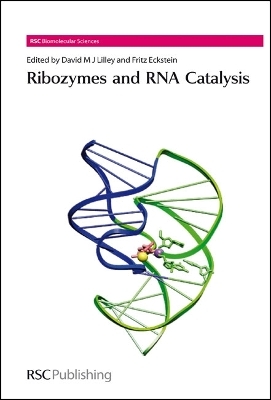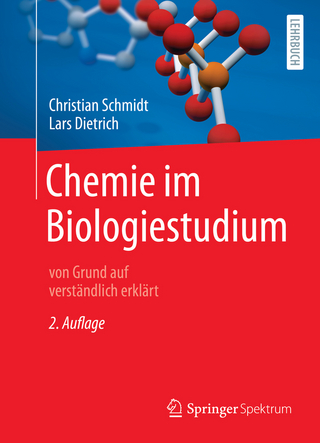
Ribozymes and RNA Catalysis
Royal Society of Chemistry (Verlag)
978-0-85404-253-1 (ISBN)
- Titel z.Zt. nicht lieferbar
- Versandkostenfrei innerhalb Deutschlands
- Auch auf Rechnung
- Verfügbarkeit in der Filiale vor Ort prüfen
- Artikel merken
The discovery that RNA could act as a macromolecular catalyst in the cell, signified a paradigm shift in molecular biology. Ribozymes and RNA Catalysis takes the reader through the origins of catalysis in RNA and necessarily includes significant discussion of structure and folding. The main focus of the book concerns chemical mechanism with extensive comment on how, despite the importance of RNA catalysis in the cell, its origins are still poorly understood and often controversial. The reader is given an outline of the important role of RNA catalysis in many aspects of cell function, including RNA processing and translation. There has been a significant coming together in the field of RNA in recent years and this book offers a compelling review of the whole field to date. Written by leading experts in their field, who in turn review the structural and mechanistic data for all known ribozymes this book is well suited for undergraduates, postgraduates and researchers in catalytic chemistry as well as those in related fields who require a unique overview of the subject.
Preface: Foreword: Twenty-five years of ribozymes;
Chapter 1: Ribozymes and RNA Catalysis Introduction and Primer;
1.1. What are ribozymes?;
1.2. What is the role of ribozymes in cells?;
1.3. Ribozymes bring about significant rate enhancements;
1.4. Why study ribozymes?;
1.5. Folding RNA into the active conformation;
1.6. The catalytic resources of RNA - making a lot of a little;
1.7. Mechanisms and catalytic strategies of ribozymes;
1.8. The impact of new methodologies to study ribozymes;
1.9. Finally;
Chapter 2: Proton Transfer in Ribozyme Catalysis;
2.1 Scope of Chapter and Rationale;
2.2 Overview of Proton Transfer Chemistry;
2.3 General Considerations for Proton Transfer in RNA Enzymes;
2.3.1 Classes of Protonation Sites in RNA;
2.3.2 Driving Forces for pKa Shifting in RNA;
2.3.3 Quantitative Contributions of Proton Transfer to RNA Catalysis;
2.4 Proton Transfer in Small Ribozymes: 5 case studies;
2.4.1 Why Small Ribozymes?;
2.4.2 Proton Transfer in the Hepatitis Delta Virus Ribozyme;
2.4.3 Proton Transfer in the Hairpin Ribozyme;
2.4.4 Proton Transfer in the Hammerhead Ribozyme;
2.4.5 Proton Transfer in the VS Ribozyme;
2.4.6 Proton Transfer in the glmS Ribozyme;
2.5 Conclusion and Perspectives;
2.6 References and Footnotes;
Chapter 3: Finding the hammerhead active site;
3.1. Introduction;
3.2. Background;
3.3. Experimental data;
3.1.1 Mechanistic Hypothesis Leads to Identification and Functional Test of Active Site Components;
3.1.2. Structural Hypothesis-Large-scale Conformational Changes are Required for Catalysis;
3.1.3. Molecular Modeling of a Hammerhead Active Fold that Satisfies Structural and Biochemical Constraints;
3.4. Current Status and Future Prospects;
Chapter 4: Hammerhead Ribozyme Crystal Structures and Catalysis;
4.1 Introduction;
4.2 A Catalytic RNA Prototype;
4.3 A Small Ribozyme;
4.4 The Chemistry of Phosphodiester Bond Isomerization;
4.5 The Hammerhead Ribozyme Structure Nailed Down;
4.6 Catalysis in the Crystal;
4.7 Making Movies From Crystallographic Snapshots;
4.8 An Ever-Growing List of Concerns;
4.9 Occam's Razor Can Slit Your Throat;
4.10 The Structure of a Full-Length Hammerhead Ribozyme;
4.11 Do the Minimal and Full-Length Hammerhead Crystal Structures Have Anything in Common?;
4.12 How the Does the Minimal Hammerhead Work?;
4.13 A Movie Sequel with a Happy Ending;
4.14 Concluding remarks;
Chapter 5: The Hairpin and Varkud Satellite Ribozymes;
5.1. The nucleolytic ribozymes;
5.2. The hairpin ribozyme;
5.2.1 The structure of the hairpin ribozyme;
5.2.2 Metal ion-dependent folding of the hairpin ribozyme;
5.2.3 Observing the cleavage and ligation activities of the hairpin ribozyme;
5.2.4 The mechanism of the hairpin ribozyme;
5.3. The VS ribozyme;
5.3.1 The structure of the VS ribozyme;
5.3.2 The structure of the substrate;
5.3.3 The location of the substrate;
5.3.4 The active site of the VS ribozyme;
5.3.5 Candidate catalytic nucleobases;
5.3.6 The mechanism of the VS ribozyme;
5.4. Some striking similarities between the hairpin and VS ribozymes;
Chapter 6: Catalytic Mechanism of the HDV Ribozyme;
6.1. Introduction;
6.1.1. Hepatitis Delta Virus Biology;
6.1.2. Cleavage Reactions of Small Ribozymes;
6.2. HDV structure;
6.2.1. Determination of Crystal Structures;
6.2.2. Structure Overview;
6.2.3. Active Site;
6.3. Catalytic Strategies for RNA Cleavage;
6.4. The Active Site Nucleobase: C75;
6.4.1. Exogenous Base Rescue Reactions;
6.4.2. The Role of C75 in HDV Catalysis;
6.4.3. Resolving the Kinetic Ambiguity;
6.5. Metal ions in the HDV Ribozyme;
6.5.1. Structural Metal Ions;
6.5.2. Catalytic Metal Ions;
6.6. Contributions of Non-active-site Structures to Catalysis;
6.7. Dynamics in HDV Function;
6.8. Varieties of Experimental Systems;
6.9. Models for HDV Catalysis;
6.10. Conclusion;
Chapter 7: Mammalian self-cleaving ribozymes;
7.1 Introduction;
7.2 General features of small self-cleaving sequences;
7.3 Genome-wide selection of self-cleaving ribozymes;
7.4 The CPEB3 ribozyme;
7.4.1 Expression of the CPEB3 ribozyme;
7.4.2 Structural features of the CPEB3 and HDV ribozymes;
7.4.3 Linkage of HDV to the human transcriptome;
7.5 Possible biological roles of self-cleaving ribozymes;
7.6 Closing remarks;
Chapter 8: The Structure and Action of glmS Ribozymes;
8.1 Introduction;
8.2 Biochemical characteristics of glmS ribozymes;
8.2.1 Divalent metal ions support structure and not chemistry;
8.2.2 Ligand specificity of glmS ribozymes;
8.2.3 Evidence for a coenzyme role for GlcN6P;
8.3 Atomic-resolution structure of glmS ribozymes;
8.3.1 Secondary and tertiary structures of glmS ribozymes;
8.3.2 Metabolite recognition by glmS ribozymes;
8.4 Mechanism of glmS ribozyme self-cleavage;
8.5 Can glmS ribozymes be drug targets?;
8.6 Conclusions;
Chapter 9: A Structural Analysis of Ribonuclease P. 9.1 Introduction;
9.2 Chemistry of RNase P RNA;
9.2.1 Universal;
9.2.2 SN2-type reaction;
9.2.3 pH-dependence of the reaction: hydroxide ion as the nucleophile;
9.2.4 Metal ions in catalysis ;
9.3 Phylogenetic variation and structure of RNase P RNA;
9.4 Early studies of the RNase P RNA structure;
9.5 Crystallographic studies of bacterial RNase P RNAs;
9.6 Modeling an RNase P RNA:tRNA complex;
9.7 Modeling the bacterial RNase P holoenzyme;
9.8 Substrate recognition;
9.9 Archaeal and Eucaryal holoenzymes - more proteins;
9.10 Concluding remarks;
Chapter 10: Group I Introns: Biochemical and Crystallographic Characterization of the Active Site Structure;
10.1. Group I intron origins;
10.2 Group I intron self-splicing;
10.3 What has changed in group I intron knowledge in the last decade;
10.4 The structure of group I introns;
10.5 Crystallography of group I introns;
10.5.1 The Tetrahymena LSU P4-P6 domain;
10.5.2 The Tetrahymena intron catalytic core;
10.5.3 The Twort orf142-I2 ribozyme;
10.5.4 The Azoarcus sp. BBH72 tRNAile intron;
10.6 The structural basis for group I intron self-splicing;
10.6.1 Recognition of the 5' splice site;
10.6.2 Does the ribozyme undergo conformational changes upon P1 docking?;
10.6.3 A binding pocket for guanosine;
10.6.4 Packed stacks;
10.7 Biochemical characterization of the structure;
10.7.1 Metal ion binding and specificity switches;
10.7.2 Identification of ligands to the catalytic metal ions;
10.7.3 Correlation with metal ion binding sites within the crystal structures;
10.7.4 Nucleotide analog interference techniques;
10.8 What makes a catalytic site?;
10.9 Back to the origins;
Chapter 10: Group II introns: catalysts for splicing, genomic change and evolution;
11.1 Introduction: The place of group II introns among the family of ribozymes;
11.2 The basic reactions of group II introns;
11.3 The biological significance of group II introns;
11.3.1 Evolutionary significance;
11.3.2 Significance and prevalence in modern genomes;
11.4 Domains and parts: the anatomy of a group II intron;
11.4.1. Domain 1;
11.4.2. Domain 2;
11.4.3. Domain 3;
11.4.4. Domain 4;
11.4.5. Domain 5;
11.4.6. Domain 6;
11.4.7. Other domains and insertions;
11.4.8. Alternative structural organization and split introns;
11.5. A big, complicated family: the diversity of group II introns;
11.6. Group II intron tertiary structure;
11.7. Group II intron folding mechanisms;
11.7.1. A slow, direct path to the native state:;
11.7.2. A folding control element in the center of D1;
11.7.3. Proteins and group II intron folding;
11.8 Setting the stage for catalysis: proximity of the splice sites and branch-site;
11.8.1. Recognition of exons and ribozyme substrates;
11.8.2. Branch-site recognition and the coordination loop;
11.9. A single active-site for group II intron catalysis;
11.10 The group II intron active-site: what are the players?;
11.10.1. Active-site players in D1 and surrounding linker regions;
11.10.2. Domain 3 and the J2/3 linker;
11.10.3. Domain 5: structural and catalytic regions;
11.11 The chemical mechanism of group II intron catalysis;
11.12 Proteins and group II intron function;
11.12.1. Maturases;
11.12.2. CRM-domain plant proteins;
11.12.3. ATPase proteins;
11.13 Group II introns and their many hypothetical relatives;
11.14 Group II introns: RNA processing enzymes, transposons, or tiny living things?;
Chapter 12: The GIR1 branching ribozyme;
12.1 Introduction;
12.2 Distribution and structural organization of twin-ribozyme introns;
12.3 The biological context;
12.3.1 Three processing pathways of a twin-ribozyme intron;
12.3.2 Processing of the I-DirI mRNA;
12.3.3 Conformational switching in GIR1;
12.4 Biochemical characterization;
12.4.1 GIR1 catalyzes three different reactions;
12.4.2 Characterization of the branching reaction;
12.4.3 The biochemistry of GIR1;
12.5 Modelling the structure of GIR1;
12.5.1 The overall structure;
12.5.2 Coaxially stacked helices;
12.5.3 The junctions and tertiary interactions involving peripheral elements;
12.5.4 The active site;
12.6 Phylogenetic considerations;
12.7 Concluding remarks;
Chapter 13: Is the spliceosome a ribozyme?;
13.1 Similarity to group II self-splicing introns;
13.2 Role of snRNA in the spliceosome active site;
13.3 Conformation of the U2-U6 complex and parallels to group II intron structures;
13.4 RNA-mediated regulation in the spliceosome;
Chapter 14: Peptidyl Transferase Mechanism: The Ribosome as a Ribozyme;
14.1 Introduction: Historical background;
14.2 The ribosome;
14.3 The peptidyl transfer reaction;
14.3.1 Characteristics of the reaction off the ribosome;
14.3.2 Enzymology of the peptidyl transfer reaction;
14.3.2.1 Potential mechanisms of rate acceleration by the ribosome;
14.3.2.2 Experimental approaches to reaction on the ribosome;
14.3.2.3 pH-rate profiles;
14.3.2.4 Activation parameters;
14.4 The active site;
14.4.1 Structures of the reaction intermediates;
14.4.2 Conformational rearragements of the active site;
14.4.2.1 Induced fit;
14.4.2.2 Role of the P-site substrate;
14.4.2.3 Conformational flexibility of the active site;
14.4.3 Probing the catalytic mechanism: Effects of base substitutions;
14.4.4. Importance of the 2?-OH of A76 of the P-site tRNA;
14.5 Conclusions and evolutionary considerations;
Chapter 15: Folding Mechanisms of Group I Ribozymes;
15.1. The multi-domain architecture of group I ribozymes;
15.2. RNA Folding Problem;
15.2.1 Hierarchical Folding of tRNA;
15.2.2 Coupling of Secondary and Tertiary Structure;
15.3. Late events: Formation of Tertiary Domains in the Tetrahymena Ribozyme;
15.3.1 Time-resolved Footprinting of Intermediates;
15.3.2 Misfolding of the intron core;
15.3.3 Peripheral Stability Elements;
15.4. Kinetic Partitioning among Parallel Folding Pathways;
15.4.1 Theory and Experiment;
15.4.2 Single Molecule Folding Studies;
15.4.3 Estimating the Flux through Footprinting Intermediates;
15.4.4. Kinetic Partitioning in vivo;
15.5. Early Events: Counterion-dependent RNA collapse;
15.5.1 Compact Non-Native Form of bI5 Ribozyme;
15.5.2 Small Angle X-ray Scattering of Tetrahymena Ribozyme;
15.5.3 Native-like Folding Intermediates in the Azoarcus Ribozyme;
15.5.4 Early Folding Intermediates of the P4-P6 RNA;
15.6. Counterions and Folding of Group I Ribozymes;
15.6.1 Metal Ions and RNA Folding;
15.6.2 Valence and Size of Counterions Matter;
15.6.3 Specific Metal Ion Coordination and Folding;
15.7. Protein-dependent folding of group I ribozymes;
15.7.1 Stabilization of RNA Tertiary Structure;
15.7.2 Stimulation of Refolding by RNA Chaperones;
15.8. Conclusion;
| Reihe/Serie | RSC Biomolecular Sciences ; Volume 10 |
|---|---|
| Verlagsort | Cambridge |
| Sprache | englisch |
| Maße | 156 x 234 mm |
| Gewicht | 675 g |
| Themenwelt | Naturwissenschaften ► Biologie ► Biochemie |
| Naturwissenschaften ► Chemie ► Organische Chemie | |
| Naturwissenschaften ► Chemie ► Physikalische Chemie | |
| ISBN-10 | 0-85404-253-9 / 0854042539 |
| ISBN-13 | 978-0-85404-253-1 / 9780854042531 |
| Zustand | Neuware |
| Informationen gemäß Produktsicherheitsverordnung (GPSR) | |
| Haben Sie eine Frage zum Produkt? |
aus dem Bereich


